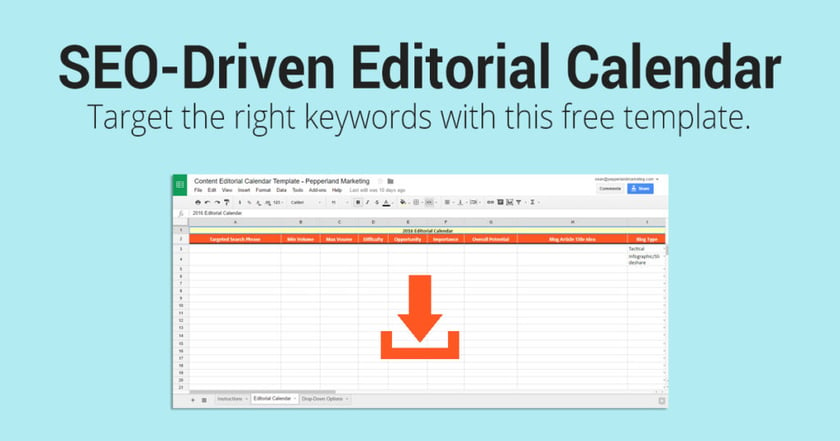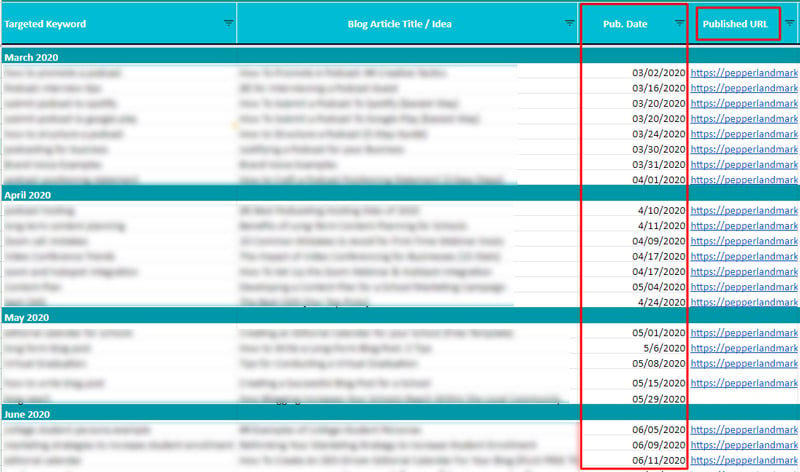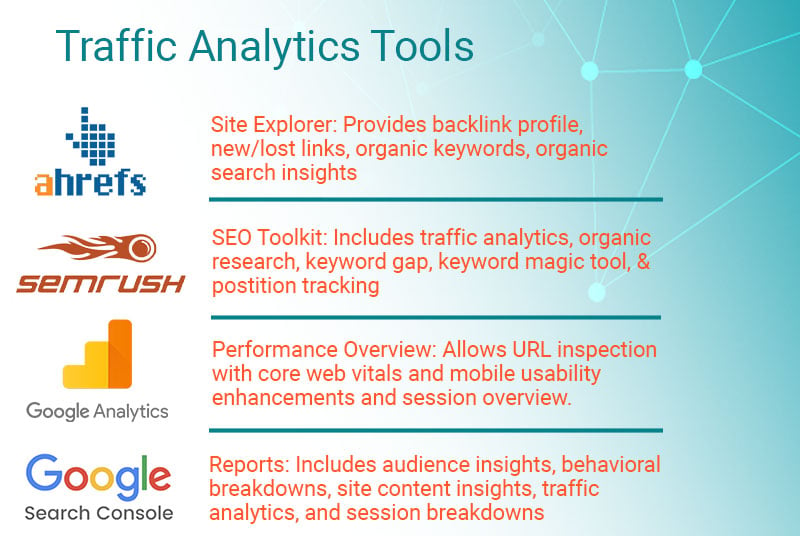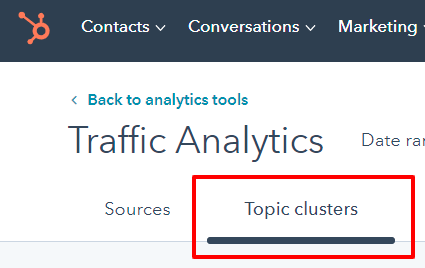Written By:
Will Purcell
If you want to improve your content marketing efforts, a thorough content audit is a great place to start. And, one of the most effective, and often overlooked auditing tools includes an editorial calendar. To perform an effective audit using an editorial calendar, it’s important to remember:
-
An SEO-driven editorial calendar works as more than just a scheduling document
-
Routine editorial calendar management is needed for the best results
-
Filtered data in an editorial calendar provides the roadmap for future content
If you’ve created content in any capacity, regardless of the industry or organization, you know how important it is to produce results. But what if your content has become stagnant? What if it’s not ranking in search, or if it isn’t converting leads like you thought it would? How do you improve your efforts?
The simple solution? Conduct a content audit.
If you’ve never conducted a content audit before, it’s easy to feel overwhelmed. Just creating a list of content URLs on your website alone can be challenging. But of course, you need more than just a list of URLs: You also need data that you can use to understand how your content is performing and which might offer insights into how you can improve.
Fortunately, an editorial calendar can alleviate all of these stresses. Here’s how.
Why use an editorial calendar to conduct a content audit?
Simply put, an editorial calendar is the best launching point for a content audit because it:
- Saves time
- Is relatively easy to use
- Provides transparency
How exactly does an editorial calendar do this? For one, it keeps all of your content in one organized place. Timothy Stobierski, the Senior Content Strategist for Pepperland explains:
“An editorial calendar is a shared document, usually in the form of a spreadsheet, that’s used to organize all of a company’s content.”
The key word Tim uses is “all”—meaning with an editorial calendar you shouldn’t have to keep multiple tabs open on your browser just to find different pieces of content. Moreover, an editorial calendar’s accessibility makes it easier for an organization to share materials across virtually any platform.
This type of transparency is not only helpful for reviewing materials during a content audit, but it’s also a great way for stakeholders to follow the progress of content during a campaign.
What’s been published? What’s scheduled for this month? These questions can be answered by effectively managing your editorial calendar.
Conducting a Content Audit Using an Editorial Calendar
The key to using an editorial calendar for a content audit is to use a calendar that’s SEO-driven. An SEO-driven editorial calendar provides the framework for developing a solid content audit by including certain terms and elements you’ll need to produce the most accurate results.

Need help getting started? Download our free editorial calendar template and follow the steps below to optimize your content marketing efforts and build a winning strategy.
1. Define and understand your goals.
It’s not uncommon for marketers and content creators to be pressed into a situation where stakeholders need a specific increase in new revenue or sales by a certain date. Given that content can, and probably should be a driving factor for that growth, it’s critical to define what you want your content to achieve and how you’ll work to achieve it.
While every organization will differ in goals and objectives, it’s nearly a universal benefit for all content creators to use SMART marketing goals.
That’s because the framework of these goals are built on tangible and measurable metrics. For content creators, these metrics include corresponding KPIs that outline a blog’s value to an organization.
Maximize your Content with our FREE Editorial Calendar Template
Creating SMART goals for content also outlines how a blog can provide value to a sales pipeline.
So, when you review data for your blog it’s important to look back on your goals and simply ask: Is this post helping achieve our goals?
Additional Resources:
2. Organize your data.
We mentioned this earlier, but one of the key benefits for using an editorial calendar to conduct a content audit is that it saves time. It does this by automatically gathering key data in one place, which you can then quickly analyze.
As you can see in the screenshot below, this editorial calendar is updated each time a new piece of content is published. It includes a lot of important information, like the pub date, published URL, targeted keyword, etc., which can all be leveraged in a content audit. This makes it much easier to actually audit your content.

A solid strategy is to start organizing data based on published dates. From there, you can analyze individual performance metrics and apply conditional formatting outlines in your spreadsheet.
3. Audit your content based on performance.
When it comes to performance the key question is: What exactly are you looking for? To answer this, it’s helpful to reference your goals.
For example, if your content campaign is built with the sole intention of guiding visitors to your sales funnel, a key metric to monitor performance would be the conversion rate.
Or, perhaps your content is built with the goal of driving traffic to your website. In that case, an important metric to monitor would be page sessions and impressions.
The specific goals for each content marketing campaign will no doubt vary, but these are the most common metrics marketers look for when evaluating performance:
- Website Sessions
- Bounce Rate
- Keyword Rankings
- Inbound Links
- Conversion Rate
- Cost Per Lead
To calculate these metrics, what service or platform should you use? For traffic breakdowns, we’d suggest going with Ahrefs, SEM Rush, Google Analytics, or Google Search Console. That’s because each of these platforms offer specific tools that can aid in determining your blog’s performance—see below.

PRO TIP: It’s best to analyze and evaluate performance data every 90 days, especially for new content. This provides a quick snapshot of how content is performing over a short period of time and allows your team to make any quick adjustments to newer posts.
Once you have your data, start categorizing your articles by performance. We find it helpful to use conditional formatting in Google Sheets because it provides a clear view of what’s performing well and what isn’t.
Once you have a formatted view of your sheet, start identifying weaknesses in your content.
For instance: Did a particular post perform well earlier than expected? What particular aspect of that article stood out? Can you replicate that on future posts? Or, did an article posted a year ago return effective results? If not, why might that be the case? How can you avoid that with future content?
It’s critical to answer these questions you need to know why content isn’t performing as well as it should. Sometimes all that’s needed is a simple SEO fix, while other situations will require a deeper dive into the searcher’s intent.
4. Plan your new content strategy.
Regardless of the performance results from previous content, there’s always room to grow. That’s why the best place to start researching new strategies lies within your current content.
If you’ve been creating content for a long time, it’s easy to think that you may have already covered all of the possible topics that relate to your business. But the fact of the matter is that this is unlikely. A content audit can help you identify those topics that you have not comprehensively covered on your site.
You could do this analysis in a number of ways, but one really effective way is to group your content based on category or tag. By filtering your editorial calendar in such a way, it will become really obvious where the opportunities exist.
Using a tool like HubSpot’s Topic Clusters report is another great way of identifying those gaps. A good starting point would be to review previous topic clusters for your campaign and go through this list of questions:
- Did we cover all materials related to our topics?
- Are there any updates to our topic that would now be relevant to include?
- Is there a particular post that needs to be updated to match the latest news and updates surrounding our topic?
- What other questions might we be able to address that a potential customer would find value from?

For example, you might discover that you have thoroughly discussed one category of content with a full 24 blog posts, while all other categories have only been supported with 6 blog posts each. Using this insight, you might then decide to build out each of those categories in a targeted way.
In addition to filling “topic” gaps, it’s also important to analyze your content through the lens of the buyer’s journey. Do you have content addressing each stage that your buyer goes through, from Awareness to Consideration to Decision? If not, building out the portion where you are lacking can help your funnel convert more website visitors into leads and, ultimately, customers.
Take, for example, the drastic changes nearly every organization has undergone in the past year as a result of the Covid-19 pandemic. How has this impacted your business? Are there any articles that should be updated to reflect these changes?
Remember, a key component of SMART goal-setting for content is to make your information timely. Even if your blog’s performance is solid with minimal gaps, it’s important to cross-check and update your buyer’s persona to determine any and all updates for what that potential customer is looking for in a search.

The more value your content provides in establishing a solid solution to your persona’s challenges, the more likely you are to rank well, increase traffic, and grow your business.
Start Your Content Audit by Downloading an SEO-Driven Editorial Calendar.
So, as you can see, an SEO-driven editorial calendar helps provide the foundation for optimizing older content while creating a roadmap for future strategies.
The key is to remember with content, there’s always room to grow. Whether your materials need a tune-up, small update, or a complete rewrite, conducting an audit can shed light on what’s needed for the best results.
Ready to get started? Download our free editorial calendar and start conducting effective, efficient, and timely content audits to maximize your marketing efforts!








